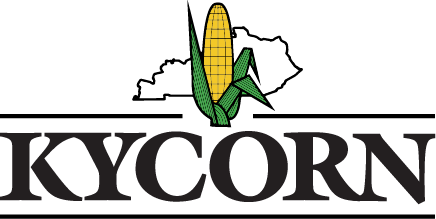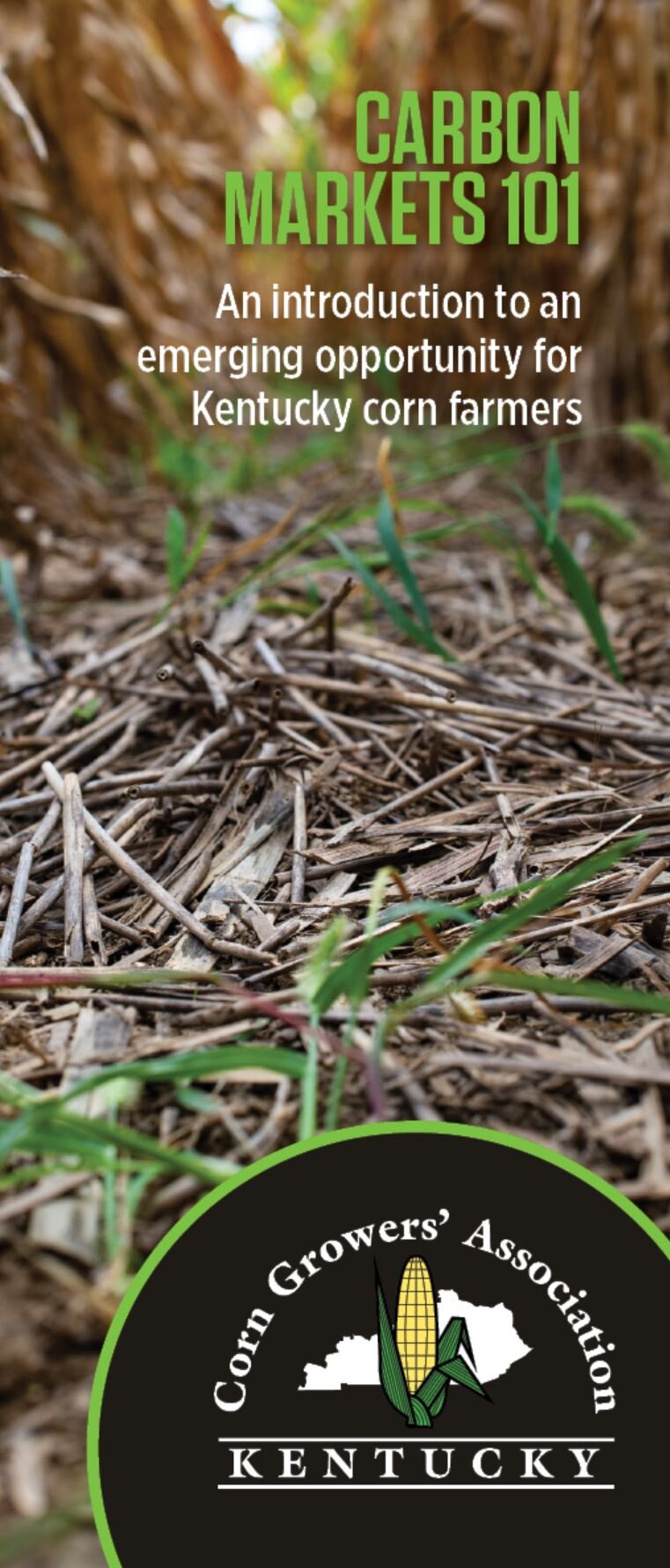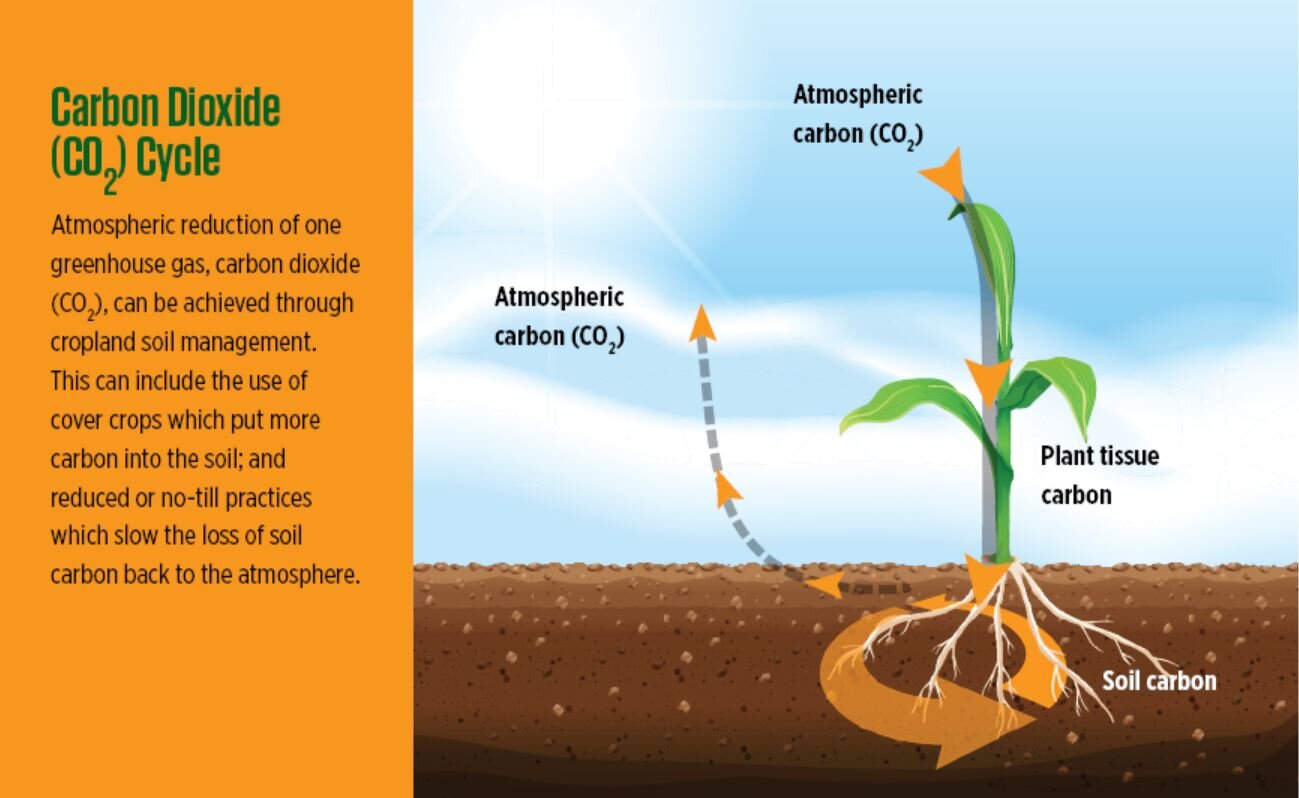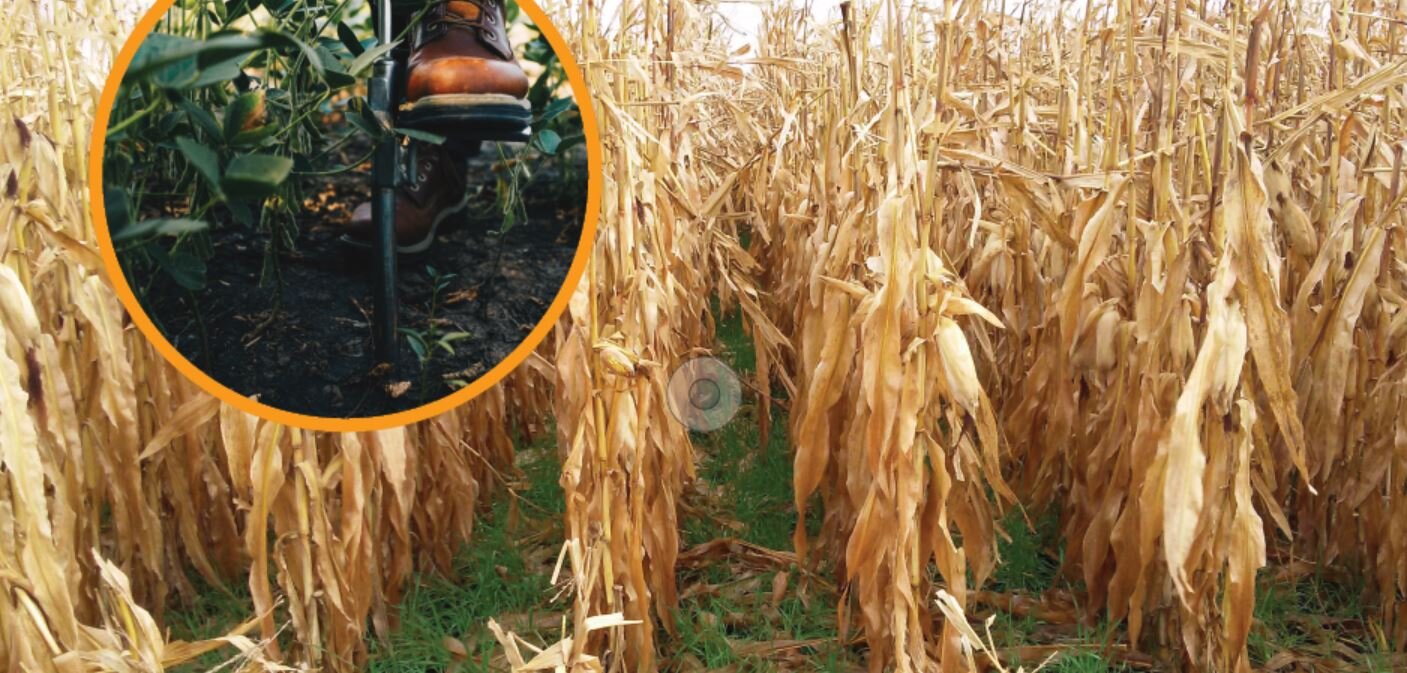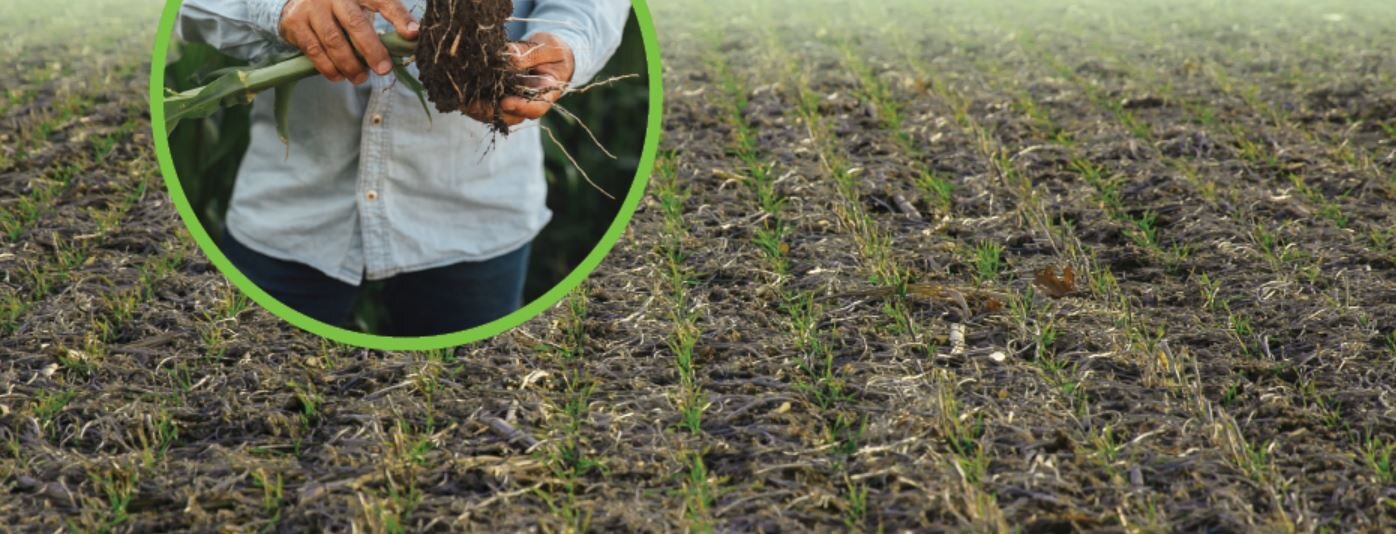carbon markets 101
Carbon is one of the most abundant elements in the universe.
Nearly 20 percent of the human body is carbon. In fact, carbon has been called the “duct tape of life” since it is at the core of more chemical compounds than all other elements combined.
But certain forms of carbon pose a serious problem for our planet. Carbon dioxide—especially emissions from fossil fuels—is the most prevalent greenhouse gas (GHG). Rising levels of carbon dioxide (also referred to as “CO2”) are driving climate change, extreme weather events, air pollution and increased human health concerns.
If we could only find a way to trap carbon gas—to capture it and keep it out of the atmosphere—we could begin to address the very real threats caused by carbon emissions.
There is a way. And it’s creating a potential revenue opportunity for corn farmers.
By capturing carbon in the soil through prescribed conservation practices, farmers may be compensated for helping other entities offset their carbon gas emissions.
The new carbon markets present yet another opportunity for corn farmers to contribute to the health of the planet—and potentially improve their bottom line.
This publication avoids providing specific information on programs, pricing and marketers since the carbon market landscape is changing rapidly. Instead, we invite you to use this basic information to orient yourself and guide your efforts as you explore the opportunities that may exist for you and your farm in the emerging carbon markets.
Carbon Market FAQs
Is carbon in the soil the same as carbon in the atmosphere?
Atmospheric carbon—or carbon gas—is a greenhouse gas (GHG). Carbon captured in the soil is in a solid form. Conservation practices such as cover crops and reduced/no-till put more solid carbon in the soil and slow the loss of carbon back into the atmosphere. The ability to capture and store carbon in the soil is the reason farmers and ranchers are poised to participate in carbon markets.
Why are farmers being compensated for sequestering carbon?
Carbon gas emissions are a significant focus as the world deals with the effects of climate change, greenhouse gas emissions, air quality and human health. Several studies have identified agriculture—and specifically croplands—as holding significant promise in storing (sequestering) carbon in soil. Accumulating carbon in soil reduces the amount of carbon gas in the atmosphere, thereby mitigating global climate change.
A growing number of companies and retail brands are voluntarily adopting sustainability initiatives all along their supply chain in order to reduce their carbon footprint and become more “green” in response to consumer and stakeholder demand. Additionally, strict regulations regarding carbon emissions such as those in California, are prompting companies to find ways to comply.
As part of their carbon reduction strategy, these companies are willing to pay for someone else to store carbon by purchasing carbon credits (also called “carbon offsets”) which may be tradable and transferrable.
These credits are then applied toward a company’s total carbon output, helping them reduce their overall carbon footprint.
In order to claim an emission reduction toward a company’s GHG goals, the purchase must “retire” the credit—making it both accounted for and no longer available for trade or purchase.
At this point, the majority of agricultural carbon efforts exist in the voluntary category rather than the area of regulatory compliance.
As a result, farmers are being presented with the opportunity to help improve the environment, verify that they are in fact doing so, and create potential revenue in the process.
Carbon retention in the soil also provide agronomic benefits for farmers in the form of improved fertilizer and water retention, reduced erosion and improved biodiversity of beneficial soil microbes.
What are “carbon markets”?
Carbon markets are where carbon credits are generated, bought and sold. A central registry is maintained to verify, validate and account for the generation, purchase and ownership of carbon credits.
Carbon markets are made up of these key players:
-
Farmers, ranchers and landowners (Sellers) who implement conservation practices that sequester carbon, thereby creating carbon credits that are sold in a carbon market.
-
Buyers including private companies and/or brokers looking to purchase carbon credits.
-
Project managers/owners (also called aggregators or technical service providers) facilitate the transaction between buyers and sellers. They ensure quality of data collection, adherence to special accounting rules, and proper recording of outcomes. Farmers, ranchers and landowners need to engage with a project manager/owner in order to enroll in carbon credits/offsets programs.
-
Project developers design and execute the project, have legal title to sell the carbon credit, select a third party standard that will ultimately verify the credits, and manage the verification process. This could be the project owner, a consultant or a specialized services provider.
-
Third-party verifiers validate that the correct on-farm and data collection protocols are followed with project managers. They also certify carbon credits with the registry.
-
Carbon registries develop the carbon protocols and standards to be followed in a project. They track projects, establish verification standards and issue credits for each unit of emission reduction or removal that is verified and certified. Registries also record the ownership of credits and record when carbon credits are applied/retired.
There are many voluntary carbon market options available to farmers as companies respond to consumer demand, meet stakeholder expectations and/or look to implement their internal sustainability initiatives. Some market options are offered by well-known agribusinesses, while others are relatively new entities created specifically for the carbon sector.
What can I do to increase soil carbon?
Soil carbon storage can be amplified through the use of cover crops, conversion to no-till or reduced till practices and diverse crop rotation. Practices that increase soil carbon help farmers as well by improving soil health and nutrient retention, reducing erosion and increasing resilience to extreme weather.
On rangeland, practices such as rotational grazing and preservation of rangeland can also lead to increased levels of soil carbon.
What if I’ve already been using these practices?
The emphasis in many programs at this point is on “additionality”—the adoption of practices specifically with the intent of generating carbon offsets, with the funds received from those offsets paying for those management changes which otherwise would not have been implemented.
Farmers who have previously been using conservation practices such as cover crops and no-till may be eligible for some carbon offset programs that offer “lookback” or “vintage” credit for practices implemented for a specific period of time prior to the establishment of a carbon contract. At this point, however, most payments to farmers will be based on the adoption of new practices.
How is soil carbon on my farm verified and sold?
Soil testing for carbon credits typically includes measuring organic carbon and bulk density at multiple depths at the outset of the practice and again some time later—usually after a few years. Additional tests may be conducted within that period.
Project managers/owners work with farmers and the third-party verifiers to validate that the management practices and data collection align with registry requirements. They also provide data to the registry, which then certifies the credits and records them on a ledger once the verifier can document adherence to the requirements.
The cost of third-party verification is usually borne by the project manager. The project manager either owns and retires the carbon credits for their own climate goals—or serves as a broker to other companies seeking credits to offset their carbon gas emissions.
Do I need to use a project owner/manager as a broker?
Some project owners/managers can also serve as brokers, i.e. third-parties that purchase carbon credits from farmers and sell them to (or acquire them on behalf of) companies either on contract or on the open market—taking a percentage in the process. Deciding to work with a broker depends on their revenue model, your knowledge, risk tolerance, level of involvement and the program in which you are participating.
What if I’m farming on rented land?
While the property owner will ultimately need to consent to contract terms, management practices related to carbon sequestration are usually determined and performed by the farmer-operator. It’s important that the division of carbon credit responsibilities and payments be clearly specified in carbon contracts
and in the rental agreement between landowner and farmer-operator.
10 Key Questions You Should Ask As You Consider Participating in Carbon Markets
There are a number of companies participating in the carbon market space including both well-known agribusiness corporations and new start-ups—with more players emerging as this concept gains acceptance. Without a national carbon market policy to establish standards, it’s incumbent upon farmers to do some research on the types of programs available, the expertise and experience behind them.
As you consider your options, be sure you know the answers to these questions:
-
How and when do I get paid? The compensation models vary by platform. Some programs pay by the acre for adopting specified management practices without regard to carbon capture. Others pay per verified carbon credit which is calculated on a per-ton basis. You’ll also want to understand payment schedules and the percentages that may be held back by the contracting entity.
-
Who owns the data gathered from my farm? Transparency and data security are key issues. By participating in carbon markets, you may be required to provide current and historical data on your operation, allow audits, and permit soil sampling. You need to understand what is expected of you and how the information gathered will be used and by whom. Is your information being shared beyond the specific carbon market program for which you are contracted? If so, why—and with whom?
-
Is there an acreage minimum to participate? There is significant variance in acreage minimums across programs. Some require no minimum, while others range from 10 acres on up.
-
How is carbon being measured? You should understand the process being used and confirm that their carbon sequestration projections are in line with those of other industry sources. You’ll also want to know the project is following a protocol that is approved by a carbon registry—and you’ll want to know which registry is being used. Also make sure the verifying organization does not have a conflict of interest in the measurement process.
-
How long am I committed to the program? The effect of management practices on increasing soil carbon levels can take multiple years. Understand the contract length, terms and exit clauses. Some platforms are year-to-year contracts with annual renewal while others require commitments of 10 to 20 years or more. Some platforms and verification protocols recognize the impact that crop failures, weather and soil conditions can have on soil carbon in any given year. Understand what is included (and excluded) in any “act of God” clauses in the contract. If you’re renting land, you’ll want to take that into consideration before signing a long-term contract.
-
What happens if I lose carbon—or fail to increase it? Your carbon credit contract should clearly outline the consequences of losing carbon—known as “reversal”—or not meeting targets. In some cases, this could result in having to pay back compensation you receive in part or in full.
-
What is the business/revenue model of the marketplace? You deserve to know how the contracting entity is structured in terms of its revenue stream, fiscal strength and payment schedule.
-
What other costs, fees, premiums or penalties are involved? Understand not only what and how you’re being paid, but also what your financial obligations are to third parties, verification services, etc. as well as any holdbacks or percentages that are being taken off the top.
-
How is the value of carbon established? Absent a national policy and/or oversight of carbon markets, the marketplace is a bit like the Wild West. Know how each entity not only measures carbon, but how they set the price—and how that compares to other markets.
-
Is it worth it? This is a question only you can answer. Under the right circumstances, carbon markets can provide a new source of revenue. You have to determine if that revenue is adequate compensation for the effort, risk and compliance that may be involved. There are a number of online resources available as you explore the potential of carbon credits for your operation—from farm publications to news articles to information from individual carbon markets. We encourage you to keep this publication handy as you conduct your due diligence and consider your options. You may want to consult an attorney to review the contract and help you understand your rights and obligations before signing.
The emerging ecosystem services markeTS
Carbon credits are just one component of an emerging market for agriculture collectively known as “ecosystem services markets.” New opportunities may be on the horizon in terms of low carbon fuel standards, credits for biofuels production, direct carbon credit sales between farmers and buyers, water quantity and quality programs, federal legislation related to climate solutions, and more.
Agriculture is increasingly being seen as an important part of the solution as the U.S. and the world address critical issues related to the environment and climate. As environmental stewards, farmers and ranchers are uniquely positioned to contribute in innovative ways and be compensated for their efforts. As these opportunities present themselves, it is critically important that you educate yourself, ask the right questions and determine for yourself if participating in the ecosystem services marketplace makes sense for you.
